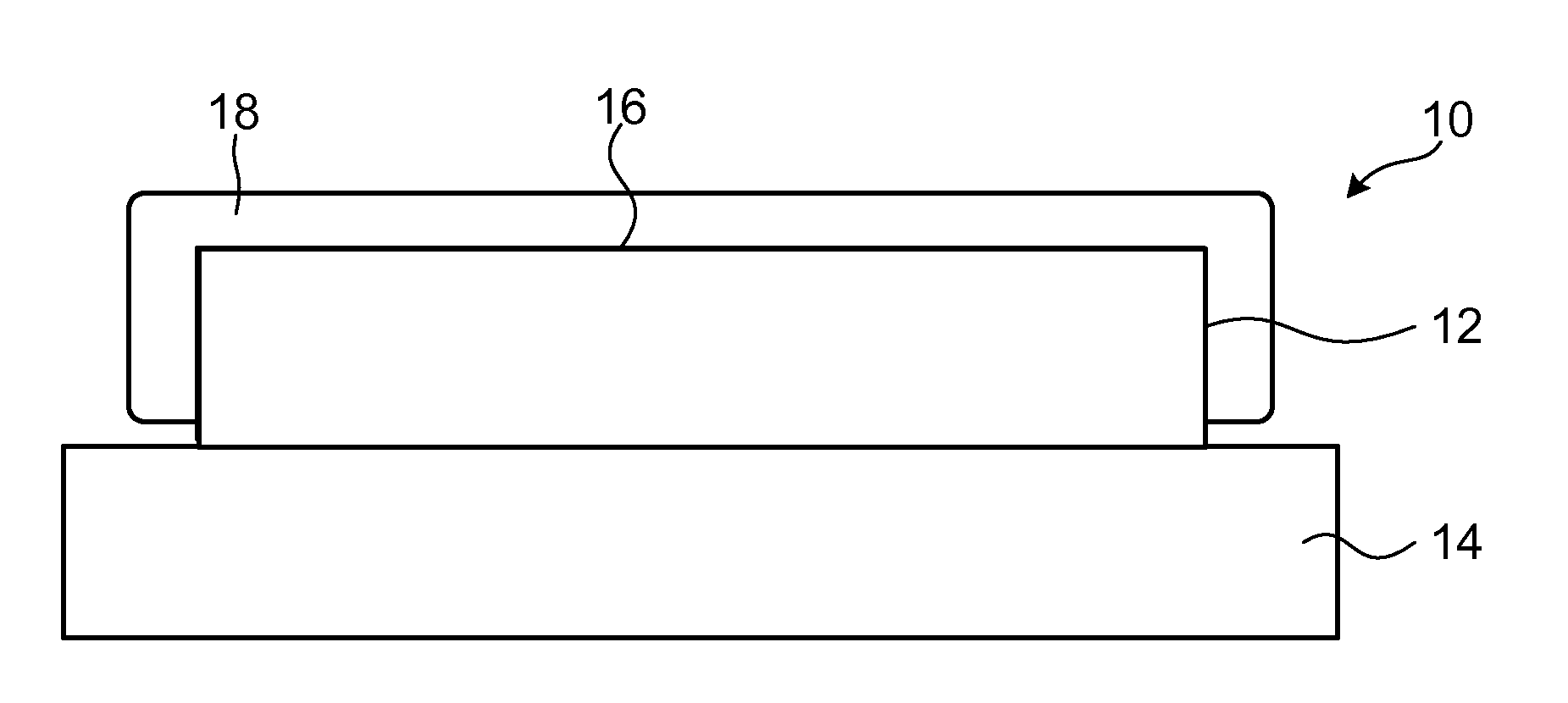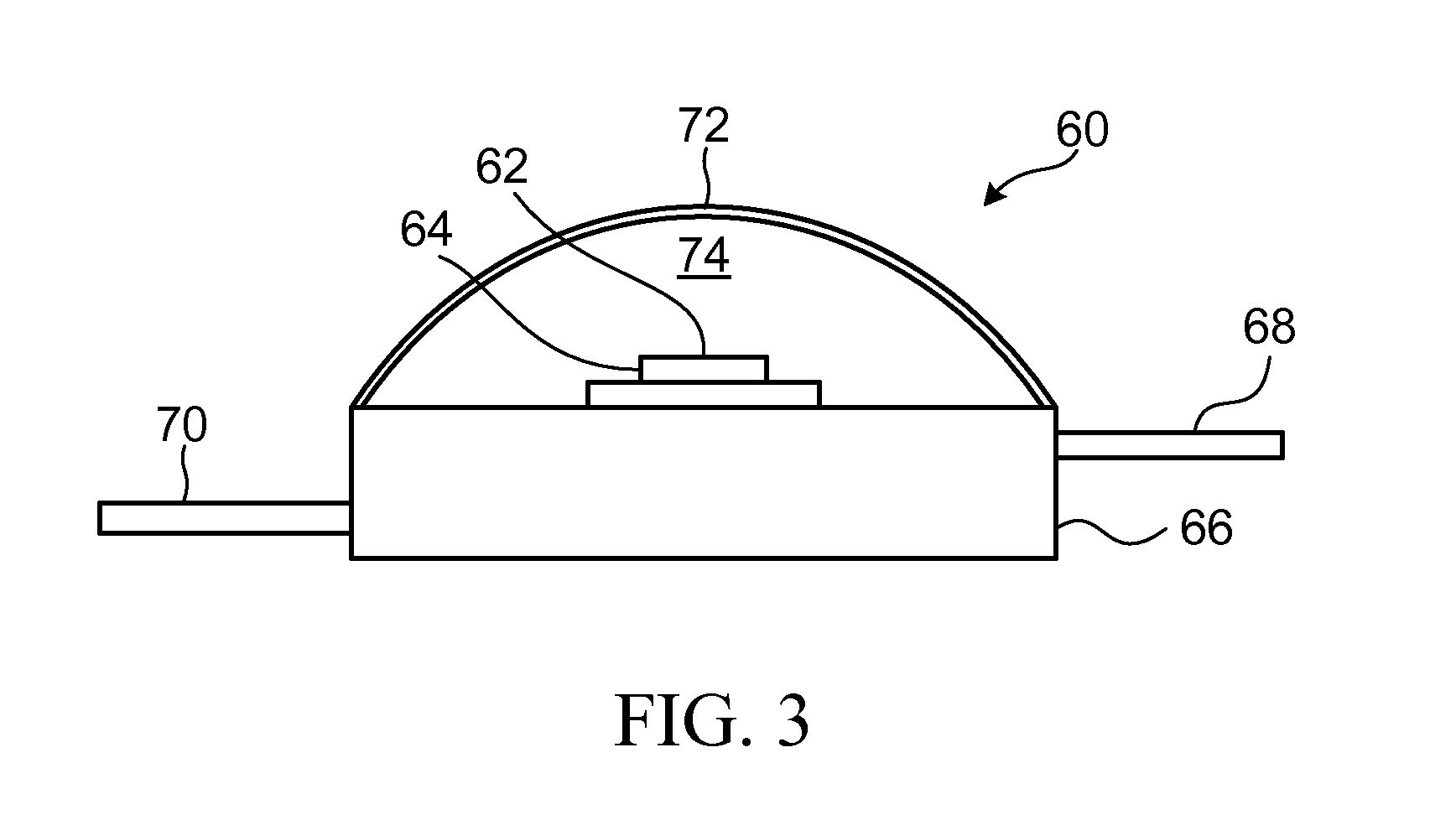Silicone Resin for Protecting a Light Transmitting Surface of an Optoelectronic Device
a technology of optoelectronic devices and silicon resins, which is applied in the direction of coatings, water-setting substances layered products, transportation and packaging, etc., can solve the problems of inability to protect the light transmitting surface of the optoelectronic device, the electrical connection to such devices is typically fragile, and the semiconductor materials used to fabricate optoelectronic devices. achieve the effect of enhancing the adhesion of the cured product and preventing the discoloration
- Summary
- Abstract
- Description
- Claims
- Application Information
AI Technical Summary
Benefits of technology
Problems solved by technology
Method used
Image
Examples
example 1
[0118]A silicone resin composition was prepared by combining (a) 100 parts of an organopolysiloxane having the formula:
wherein L=70 and m=30, and having a viscosity of 4 Pa-s, from which a low-molecular-weight fraction had been removed by alcohol washing, (b) an organohydrogenpolysiloxane having the formula:
wherein p=1 and q=4, in such an amount as to give 1.5 moles of SiH groups per mole of total silicon-bonded vinyl groups in component (a), and (c) 0.05 part of an octyl alcohol-modified solution of chloroplatinic acid (platinum concentration 2 wt %), and thoroughly mixed. Note that the ratio of SiH groups to vinyl groups is abbreviated as SiH / SiVi in Tables 1 and 2 of FIG. 4.
[0119]The organopolysiloxane with a low-molecular-weight fraction removal was obtained by repeating the alcohol washing procedure involving adding an alcohol, typically methanol to (original) vinylphenylmethylpolysiloxane, mixing at 25° C. for one hour, and decanting off the alcohol. For this organopolysiloxan...
example 2
[0122]A silicone resin composition was prepared by combining (a) 100 parts of an organopolysiloxane having the formula:
wherein L=35 and m=15, and having a viscosity of 1.5 Pa-s, from which a low-molecular-weight fraction had been removed by alcohol washing, (b) an organohydrogenpolysiloxane having the formula:
wherein p=1 and q=4, in such an amount as to give 1.2 moles of SiH groups per mole of total silicon-bonded vinyl groups in component (a), and (c) 0.05 part of an octyl alcohol-modified solution of chloroplatinic acid (platinum concentration 2 wt %), and thoroughly mixing. The composition was tested as in Example 1, with the results shown in Table 1 of FIG. 4.
[0123]The organopolysiloxane with a low-molecular-weight fraction removal was obtained by an alcohol washing procedure as in Example 1 from a vinylphenylmethylpolysiloxane of the resin structure shown above. For this organopolysiloxane with a low-molecular-weight fraction removed, the content of a low-molecular-weight silic...
example 3
[0124]A silicone resin composition was prepared by combining (a) 100 parts of an organopolysiloxane having the formula:
wherein L=20 and m=10, and having a viscosity of 0.7 Pa-s, from which a low-molecular-weight fraction had been removed by alcohol washing, (b) an organohydrogenpolysiloxane having the formula:
wherein p=1 and q=4, in such an amount as to give 0.7 mole of SiH groups per mole of total silicon-bonded vinyl groups in component (a), and (c) 0.05 part of an octyl alcohol-modified solution of chloroplatinic acid (platinum concentration 2 wt %), and thoroughly mixing. The composition was tested as in Example 1, with the results shown in Table 1 of FIG. 4.
[0125]The organopolysiloxane with a low-molecular-weight fraction removal was obtained by an alcohol washing procedure as in Example 1 from a vinylphenylmethylpolysiloxane of the resin structure shown above. For this organopolysiloxane with a low-molecular-weight fraction removed, the content of a low-molecular-weight silico...
PUM
| Property | Measurement | Unit |
|---|---|---|
| Temperature | aaaaa | aaaaa |
| Fraction | aaaaa | aaaaa |
| Fraction | aaaaa | aaaaa |
Abstract
Description
Claims
Application Information
 Login to View More
Login to View More - R&D
- Intellectual Property
- Life Sciences
- Materials
- Tech Scout
- Unparalleled Data Quality
- Higher Quality Content
- 60% Fewer Hallucinations
Browse by: Latest US Patents, China's latest patents, Technical Efficacy Thesaurus, Application Domain, Technology Topic, Popular Technical Reports.
© 2025 PatSnap. All rights reserved.Legal|Privacy policy|Modern Slavery Act Transparency Statement|Sitemap|About US| Contact US: help@patsnap.com



